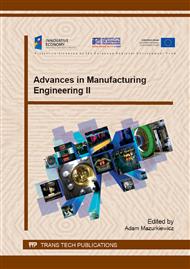p.107
p.112
p.118
p.124
p.130
p.136
p.142
p.148
p.154
Inspecting the Quality of Fly Ash and the Identification of Areas of their Economic Utilisation
Abstract:
The content of unburned carbon in the fly ash is one of the indicators that allow the assessment of the correctness of the process of the combustion of pulverized coal in conventional power plants, as well as the identification of emerging economic usefulness of ash by-products, which are used, among others, as additives for cements [1]. This forces constant quality checks of generated fly ash. Routinely such tests are carried out periodically with use of laboratory equipment. However, technological progress allows the measurements in semi-real-time on the samples of ash taken directly from a stream of air-ash aerosol. Often used methods in commercial analytical equipment are the microwave methods [2]. Other solutions, currently used in conventional power measurement systems, are devices using x-ray and dielectric methods. X-rays and the measurement of the dielectric parameters of the carbon in the ash are used in, for example, SYSKON 201. The method employed in this solution allows the detection of carbon in the ash in the concentration range from 0 to 16%. However, in this technique, the use of radiation sources requires maintenance of certain operating procedures that may pose a barrier to install this type of equipment in some power plants. It is also possible to use photo-acoustic techniques or laser light scattering [3-5]. A photo-acoustic signal is generated by the absorption of radiation by the sample placed in a sealed chamber filled with gas (nitrogen, helium). Radiation absorbed by the sample causes it to heat up and expand the surrounding gas. The heat wave penetrates the surrounding gas, generates heat at a frequency fluctuation in accordance with the frequency modulation of radiation, and causes changes in gas pressure and, consequently, the formation of the acoustic wave recorded by a highly sensitive microphone [6]. Important limitations of the industrial application of this method is the problem of placing the sample in the measuring chamber filled with an inert gas and the high sensitivity of the measuring equipment to external vibration. The presented characteristics of current methods of monitoring the quality of fly ash directly in technological conditions shows that every solution has some limitations that hinder the application in technological lines. Therefore, development work is carried out to develop other simple and effective methods for monitoring the carbon content of fly ash [7, 8].
Info:
Periodical:
Pages:
130-135
Citation:
Online since:
August 2015
Authors:
Price:
Сopyright:
© 2015 Trans Tech Publications Ltd. All Rights Reserved
Share:
Citation:


